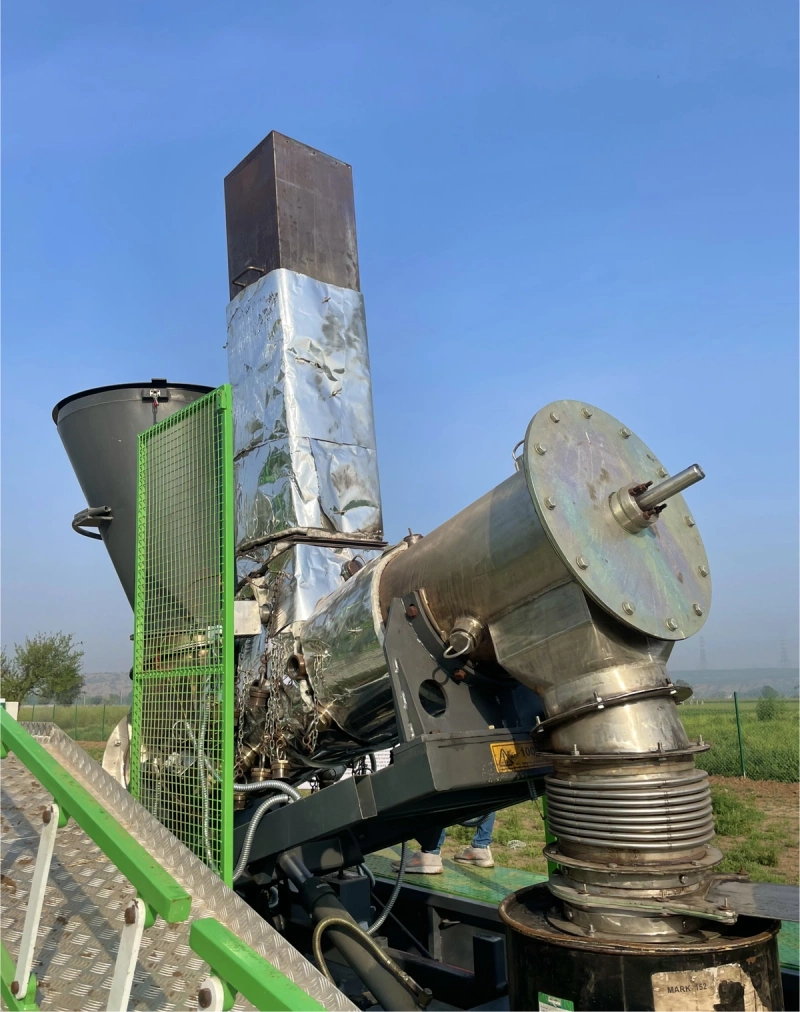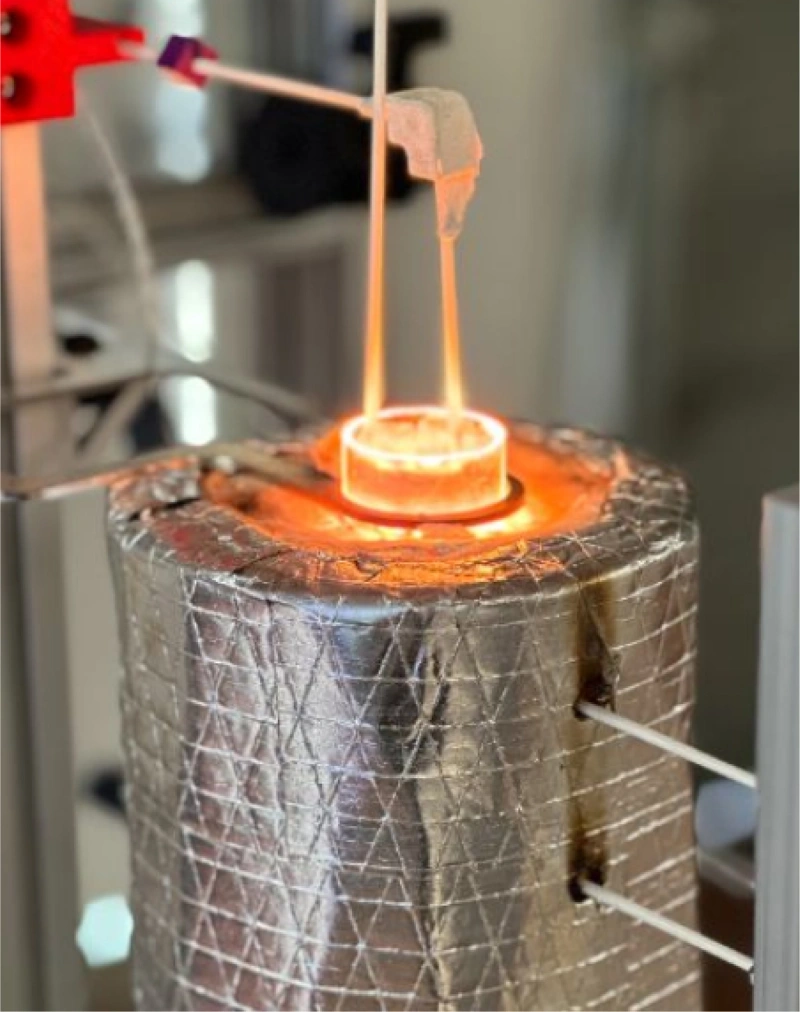Bill Gates and Paul Allen in 1979, at the beginning of their personal computer revolution
Breakthrough Energy Fellows
Discovery
In 1975, long before Microsoft was a household name, Bill Gates and Paul Allen were just two guys workshopping their ideas in an Albuquerque garage.
Forty years later, when Bill founded Breakthrough Energy, he wondered: Where were the climate tech equivalents of him and Paul Allen? Where were the garages and laboratories populated by young innovators with big ideas? Finding — and supporting — these people is the first, critical step in the journey for any good innovation, which is why we call this stage, “discovery.”

Takachar's prototype, the “Takavator," a portable machine that turns crop waste into biofuels, carbon-based fertilizer blends, and other valuable bioproducts
At Breakthrough Energy, we try to identify great ideas, long before they are associated with a company, founder, or even a catchy name — and long before they have attracted serious funding.
Why? Because we need to improve on existing technology by an order of magnitude — and we don’t even know yet what that will look like. It’s estimated that nearly half of all emissions reductions in 2050 will come from technologies that have yet to reach the market . The sky-high stakes of the climate emergency mean that we must jump-start innovation at the earliest stages, so that ideas can get into the world faster than they would under normal market conditions.
We do this through three programs.
Breakthrough Energy Fellows
Fellows
1
1
Breakthrough Energy’s Fellows program has some similarities to well-known incubators like Y Combinator and TechStars, but there are key differences.
First, our program is focused on technology. The highly technical space we work in requires a highly sophisticated vetting and selection process. We do rigorous technical diligence up front, which also helps derisk technology down the line for our Fellows’ future investors.

Furno's modular carbon-neutral cement kiln technology
Second, our Innovator Fellows — world-leading scientists and engineers with a critical climate technology to commercialize — work with a dedicated Breakthrough Energy management team that helps identify a specific set of technical milestones and checks in regularly on their progress, providing guidance and advisory support.
We also offer an unprecedented level of support for commercialization and growth through our Fellows business advisors program, which is unique in the field. These experienced industry leaders rotate from team to team, advising innovators one-on-one, on topics from fundraising and techno-economic modeling to navigating pilot opportunities and discovering customers.

BE Fellows at the Breakthrough Energy Summit
“Even with all this support, some of these highly risky technologies will hit a dead end — and that’s okay. We also consider human capital development as a goal in itself: our overall program curriculum is designed toward cultivating talent and empowering scientists to keep innovating in the climate space.”
90
Through three cohorts, we’ve already supported 90 Fellows, across 41 projects and 13 countries, in areas including cement, hydrogen, long-duration energy storage, steel, electrofuels, and carbon capture. We are continuing to scale and grow the program.
Breakthrough Energy Fellows
Explorers
2
2
There are some ideas that are too early even for Innovator Fellowships: ideas that are not yet out of the lab, let alone spun out into a company.
That’s something we realized after Fellows' first year — which is why, during Cohort Two, we added the Explorer program . Explorers are working on research at universities that might lead to a company down the line. Their ideas are not just at an earlier stage, but often also carry higher technical risk than those of our full-time Fellows.

A biologist examining a plant in a greenhouse
Explorers are primarily academics. We enable them to spend a year at their home institutions, doing commercially-focused research that wouldn't get funded by traditional sources. An example of an Explorer is a plant biologist who has developed a way to decrease the emissions footprint of staple crops, and can see a path to commercialization. We guide them to work on a specific set of experiments, and to get the “technology readiness level” of their research as high as possible — like, for instance, expanding experiments from a model species to commodity crops like corn and soybeans.
If their experiments work, they’re ready for the next stage and have a pipeline to become Fellows. Some Explorers from last year have already joined us as Innovator Fellows in Cohort Three.
Breakthrough Energy Fellows
Workshops
3
3
The final, and newest, piece of our work at the discovery stage are workshops. These are intended for us to gain insight into the critical, but often overlooked areas of scientific discovery that could unlock some holy grail solutions. Our workshops bring together scientific experts on some of the most cutting-edge subfields, like high temperature superconductors and hydrogen storage applications, to identify, at the earliest possible stage, if there are ideas or concepts that we can eventually scale up to an Explorer or Fellows project, or even straight to a company that’s ready for investment.

An illustration of a superconductor
This September, we brought together experts, researchers, and startup founders to specifically discuss metal hydrides as a new hydrogen storage option. Why? Hydrogen is a prime energy carrier — a potential replacement for fossil fuels — but safely storing hydrogen at high efficiency and low cost remains a major challenge.
Metal hydrides are a unique potential solution. They can store hydrogen inside a solid-state material using only temperature and pressure. In addition, metal hydrides have potential applications for other energy systems such as heat pumps, cooling, thermal storage, and heat upgrading.
With that in mind, we asked questions to some of the field’s leading scientists like: What kind of applications are possible if they do work? What ancillary technology might we need to make that possible? What else should we be researching around this subject? Our hope is, no matter which of these theoretical technologies work out, or when, we’ll be in a good place to develop a commercial ecosystem around it.

Wind turbines at sunrise
The Horizon
Today, some of the most promising companies in climate tech are just ideas in universities and laboratories, far from Silicon Valley, in the minds and on the work benches of brilliant scientists and engineers.
Our discovery programs find and foster the people working on those critical, yet high-risk, technologies, and help them develop their ideas before soliciting conventional scaling capital.
Across our first three cohorts , we’re working to help derisk a portfolio of high-potential technologies so that more capital can follow our trail to the most exciting climate solutions of tomorrow.
Breakthrough Energy Ventures
Development
The best way to build technologies is with tech companies, and for almost 50 years, the surest way to build tech companies has been with venture capital .
The first venture firm signed a lease on Silicon Valley’s Sand Hill Road in 1972, and ever since, the playbook for building a very big technology company very quickly has followed four steps: identify a unique way to solve a large problem using technology; secure a venture investment; use the money to hire smart people; and build a successful company.
But there’s always been an unwritten caveat to these instructions: they don’t apply if the company you’re building has something to do with the Earth’s changing climate.
Venture capital has always had a climate problem .
Scroll to navigate to
next section
Click to navigate to
next section
